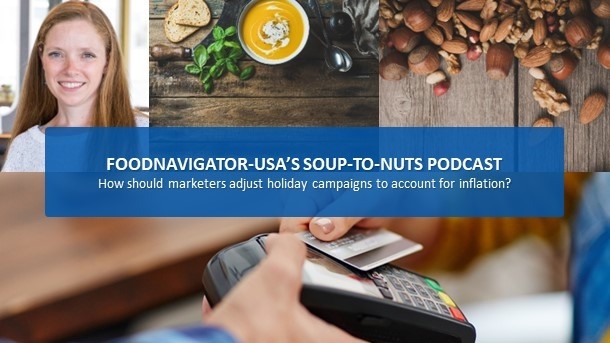Soup-To-Nuts Podcast: How should seasonal marketing campaigns account for inflation?

Consumer spending is projected to increase 4% to 6% this holiday season over 2022, but most shoppers won’t want to spend it all in one place – a challenge given the near universal price hikes across categories and segments. In response, a projected two-thirds of consumers will be on the lookout for sales, discounts and offers – which has become a contentious point between retailers and manufacturers with the former lobbying for promotions and the latter divided about whether they are worth the sacrifice to their margins.
In this episode of FoodNavigator-USA’s Soup-To-Nuts podcast, Chris Stiner, advertising agency Media Culture’s senior executive of account services shares how inflation will influence holiday shopping behavior and brainstorms strategies for successfully boosting consumer engagement and sales across channels.
[Editor’s note: Never miss another episode of FoodNavigator-USA’s Soup-To-Nuts podcast – subscribe today.]
Christmas in September?
For the last three years, inflation has been rising – at times sharply – and while consumer demand has remained unexpectedly steady in the face of wave after wave of price hikes, the elasticities manufacturers have enjoyed are beginning to slide. As consumers pull back on spending, Stiner says, they will look for more deals and they will spread out their purchases overtime so their bank accounts don’t take one big hit.
He adds the result will be an earlier-than-ever start to the holiday shopping season, which means marketers will need to move fast to catch them at the start and hold messaging steady or longer to reach them again when they return.
“Last year, for a lot of people, it felt like, ‘Hey, we can finally come back to the table with our friends or family, and have somewhat of a normal kind of holiday feel, and because of that consumer spending followed a pattern that seemed to be pretty common prior to the pandemic,” Stine said.
But, he added, “as we look towards the holidays this year, inflation is so important and it is impacting everybody, everywhere.”
As such, he said, holiday spending – and marketing and merchandising – will begin in late September and early October with big purchases coming first followed by less expensive purchases later in the season.
Amazon will lead the way pre-holiday cycles earlier than ever and other retailers will follow suit to remain competitive, he added.
A longer shopping timeline calls for longer ‘drip’ campaigns
One way Stiner says brands and retailers can better engage with consumers over the longer holiday marketing season is through what he calls a “drip campaign,” which allows brands and retailers to remind consumers of their value proposition overtime, but without overwhelming shoppers.
“A drip campaign falls into a multi-channel approach that we use and we recommend for everybody throughout the year, but especially during the holiday season, and particularly now that it is such an extended window,” Stine said.
An example of an effective drip campaign is a programmatic media buy that focuses on prospecting and retargeting at key moments along the consumer journey throughout the holiday season, he explained.
Omnichannel marketing allows companies to reach consumers where they are
According to Stiner, meeting consumers where they are this holiday season will require brands to develop campaigns that are well-rounded, play across media channels and balance high-impact placement with personalization.
Personalization is especially important for digital ads given the high level of noise in the media.
“We get a lot of different ads on the digital side of things, and if it is not something that stands out, if it is not something that speaks to us as individual, there is a high … chance that it will go unnoticed,” he explained.
For video to be most effective, Stiner recommends pairing high-impact TV or streaming spots with more targeted connected TV videos for a “one-two punch.”
As for social media, the biggest platform this holiday season will be TikTok for which 50% of users say they bought a product after seeing it on the app. Live streaming also is more effective than pre-recorded content on the platform, Stine added.
“Something that is key for this holiday season is live stream ecommerce,” which his projected to reach $30bn this year, he added.
Stiner adds that holiday campaigns that reward consumers who help spread the word about a product or brand will also engage shoppers more effectively, as will ones that tap into consumers different cultural values.
Campaigns must manage costs and margins
Consumers are not the only ones trying to save money – companies, too, need to keep costs down to help protect their margins and one way Stiner says they can do that is by harnessing data analytics and AI to better understand consumer preferences and remain nimble if their budgets change unexpectedly.
Selectively weaving in promotions as part of a broader marketing campaign can be an effective tool for scooping up fast sales, but many large CPG companies are pushing back against retailer and competitive pressure to offer heavy discounts or buy-one-get-one because they fear a race to the bottom.
When considering if promotions should be embraced or avoided, Stiner advises companies to think about their size, maturity and immediate and long-term needs. He also notes that the holiday season is a bit more promo heavy, but the deals offered in the last quarter of the year won’t necessarily impact a brand’s image the same way as promos at other times of year.
Whatever marketing strategy brands deploy this holiday season, Stiner advises they always start with clear, consistent goals and know what they want each ad or promo to achieve. While he acknowledges that may sound basic, he adds that the fundamentals are foundational for a successful campaign.
















